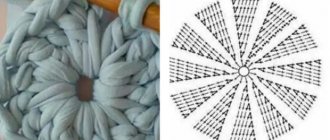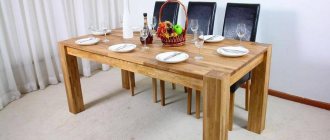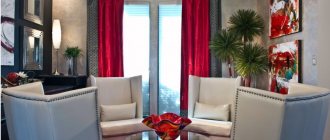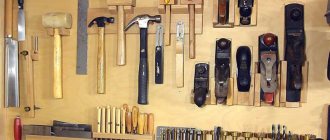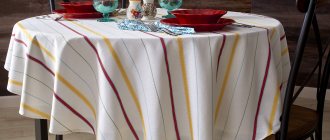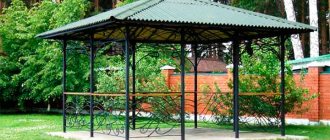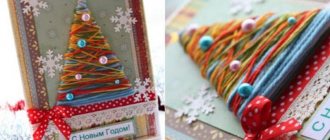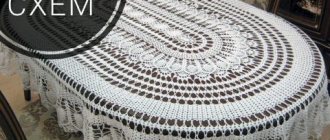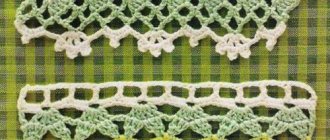DIY New Year's table runner - this idea will make the atmosphere of any holiday more comfortable, and at the same time solemn. In addition, such decisions are unique, which means the New Year will be special.
New Year's table runners are presented in a fairly wide assortment, and thanks to this, you can create or select a product that can focus attention on the style of serving and the entire room. The New Year's table runner should be combined with the main tablecloth, dishes and the room as a whole, and also be suitable in size to the tabletop.
On a note! The path must be combined not only in color and style, but also in texture, theme, and so on - disharmony is unacceptable.
Advantages of a tablecloth runner
A table can be decorated not only with a tablecloth or an exquisite complex table setting, but also with an ordinary strip of fabric. What are the advantages of such table decoration:
- A stylish, ultra-modern and fashionable solution - this is precisely the role played by the tablecloth runner when used for festive table settings. It adds sophistication and charm to the entire decoration of the feast.
- Versatility is one of the main advantages of this canvas. It can be used not only to celebrate the New Year, but also for other holidays or everyday life - an ordinary family lunch or a romantic dinner for two will be quite successfully complemented by a beautiful and practical table decoration.
- Varieties of this textile product can be used to decorate events with a small number of visitors or for large banquets - a table of any size, even the longest or widest, can be covered with such a runner.
- Great for use under cutlery on a table, thereby protecting the tabletop from damage or overheating.
- Can be a decorative element or partially replace a tablecloth.
Important! The practicality of the New Year's tablecloth directly depends on the choice of fabric.
Sewing types of tablecloths
A tablecloth woven in a factory and a tablecloth made by yourself is a huge difference, because the products you make yourself reflect your individuality and tastes.
Such “clothes” for the table help create a cozy, homely atmosphere and make get-togethers more comfortable. And if you want to bring the holiday spirit, then a handmade product will be very appropriate. For example, you can sew a New Year's tablecloth.
New Year's tablecloth
No celebration is complete without decoration. And what can we say about the New Year? On this day, every element is important, including the tablecloth on the New Year's table. You just need to choose the right fabric, cut it and stitch it.
For the fabric from which you make your own New Year's tablecloth, it is better to choose a material that is easy to wash. After all, force majeure happens quite often at the table, and no one will use a dirty coating.
The second stage is cutting. The procedure will depend on the shape of the table. Making a square version of the product is much easier, since the fabric just needs to be cut to the calculated dimensions, leaving an allowance for processing the edges. To make a round-shaped product, you should fold the material 4 times, mark the diameter, make an arc and cut it according to the marks.
It’s good when the New Year’s tablecloth is decorated with decorative elements with your own hands. It can be:
- jacquard frills;
- guipure inserts;
- ruffles.
The applications look very original, but they are worth taking on only if you have some experience.
Woven tablecloth
Nowadays, many homes are decorated with a vintage woven tablecloth. Previously, it took a lot of effort and special machines to make such a canvas. The flax was carefully prepared and only then began work. Now you can purchase ready-made fabric in a store, cut it, stitch it, trim the edges, iron it and decorate it in an original way.
Choosing New Year's fabric for paths
The fabric for the New Year's table cloth is chosen according to approximately the same criteria as the tablecloth. In this case, in addition to the New Year theme, which should, one way or another, be present on the fabric, it is necessary to decide on the type of fabric.
The fabric for the track can be:
- natural;
- synthetic;
- mixed
Natural fabrics
The best fabrics most often used for a tablecloth or runner are linen, silk or cotton. The main feature and main advantage of the materials is their presentable appearance and the ability to sew products yourself.
- Linen is distinguished by its long service life, environmental friendliness and beautiful appearance. This is a fairly durable fabric in every sense - even the pattern on it lasts for a long time even with frequent washing.
- Silk is an exquisite fabric, the New Year's runner from which will add charm to the entire table setting. This fabric is usually chosen for ceremonial feasts and important events.
- Cotton is versatile and in demand. If the table runner is made of cotton with your own hands, it will last a long time, while being quite cheap.
Synthetics
The track can be made from durable and practical synthetic fabrics. As a rule, the New Year theme is presented in such solutions not only in different colors or with a variety of designs, but also stands out with its unusual texture. The fabrics used are Teflon and polyester. Their main advantages:
- moisture resistance and water-repellent properties;
- no need to wash, just wipe with a damp sponge;
- tolerate high temperatures well.
Important! Synthetic fabrics ignite quickly and should not be laid near open flames.
Mixed
Quite popular fabrics for making New Year’s tablecloth are “Zhuravinka” and “Mati”. In the first case it is a mixture of polyester and cotton, in the second - cotton and polyester. Both varieties have a presentable appearance and are practically indistinguishable from natural canvases. But, at the same time, they are dirt- and water-repellent, practical and durable. The New Year's design will last for many years, and such paths can be used not only as table decoration, but also under cutlery.
Careful preparation is the key to a successful result
It is necessary to prepare correctly so that the result exceeds all your expectations. A number of works must be completed before starting the sewing process:
- Choose the most suitable fabric.
- Determine the shape of the future product, since the material processing technology will be different.
- Prepare the necessary tools.
Choosing material
When studying information on how to sew a tablecloth with your own hands, you will find various fabric options. These can be either synthetic, natural or combined fabrics.
You should know that for everyday use it is better that the product is made of practical material. This is considered jacquard, which has the necessary strength and is also easy to clean. Its color range is quite varied, so you can definitely choose the option that is most suitable for you. A jacquard product for the kitchen, made by yourself, will definitely attract the attention of your guests and decorate everyday meals.
If you are interested in holiday options, then it is better to give preference to natural fabrics. Sewing tablecloths for celebrations is best done from the following materials:
- Cotton . Delicate, flowing material.
- Linen . Not as practical as cotton ones, but in no way inferior in terms of external characteristics. They are not impregnated, so they are not as durable.
- Silk . For a magnificent special event, a silk product will be one of the best options for table decoration.
The choice of colors will depend on the decor of your room, as well as personal taste preferences.
Deciding on the form
To choose the right shape for a tablecloth, you need to know the following nuances:
- A rectangular table can only be covered with tablecloths of the same geometry. Sometimes special tracks are used as a covering for such countertops. This is an original design technique that can give a modern look to the interior.
- For square tables, only coverings of the same shape are suitable. To add style, two square tablecloths laid crosswise are sometimes used.
- Both square and round tablecloths look beautiful on round tables. You can even sew products of different shapes and combine them. It will look very stylish on the countertop.
- For an oval table, you can make a tablecloth in the shape of an ellipse or a rectangle.
How to make a tablecloth runner at home: step-by-step instructions
You can sew table runners with your own hands from different fabrics and with different patterns, which is especially important on the eve of the New Year holidays.
The sewing process is as follows:
- Cut out the required size of the canvas using the appropriate diagrams and taking into account the dimensions of the table.
- All sections located along the perimeter of the cut fabric are ironed inside out.
- The corners must also be turned to the wrong sides.
- Cuts are made at the corners, taking into account a 2-centimeter allowance, after which they are turned back twice, pinned and ironed.
- Corner hems are made by hand, those located along the perimeter are stitched from edge to edge on a sewing machine.
Advice! This instruction is a basic version, and you can decorate it at your discretion. For example, sew tassels to the corners, make stripes on top of the base, and so on.
Burlap tablecloth: 45 simple ideas with photos
I wanted to refresh my kitchen interior. As always, I want something new, beautiful and without any problems. The tablecloth is ideal. Below in the article you will find a small master class on how to sew it.
While I was looking for ideas, I found so much beauty that I decided to share with you a selection of photos below. And most importantly, you can do a lot of things with your own hands quite simply and quickly.
Burlap tablecloth with white lace
White lace is definitely a favorite. It gives the work lightness, airiness, a kind of weightlessness.
The kitchen will definitely become lighter and more delicate with such a tablecloth.
The classic version: thin lace is sewn along the edges of the fabric.
You can use not only thin guipure lace, but also woven one.
Or tie the edge with your own hands.
Wide lace with beautiful openwork patterns will always look advantageous.
Another idea is to make decor in the form of applique.
The second classic option for decorating a tablecloth is to simply sew lace along the free edge.
Pros of burlap
Burlap is a rather specific fabric. So to speak, with its own character.
The fabric is made from natural fibers, thanks to which it has a wide list of positive qualities:
- environmentally friendly
- good air permeability
- absorbs moisture well
- chemically inert
- resistant to insects.
Among the many advantages of this type of fabric, the following stand out:
- durability, high wear resistance
- Availability and low cost allows it to be used by a wide range of people.
For the home, burlap is remarkable because
Made from natural fibers, it is not harmful to health and does not cause allergies.
Thanks to its pronounced rough texture, it is combined with a wide variety of materials: fabric, lace, silk, wood, glass, ceramics, etc.
- has a beneficial effect on the general condition of the body
Burlap in the interior creates a special peaceful mood and a feeling of warm home comfort. This helps restore vitality, energy, and lift your mood.
Lace in the central part of the tablecloth
You can use lace to decorate a tablecloth not only along the edges. The option with it in the center of the fabric looks successful and advantageous.
- You can sew openwork stripes individually or as one wide fabric.
Decor with colored lace
- For those who don’t really like white and want something brighter, the option with colored lace is perfect.
- Delicate pastel colors will highlight the color of the burlap.
- For lovers of rich colors, tablecloths with a bright border, such as red, will suit you.
Disadvantages of burlap
Despite the large number of positive qualities, this fabric also has disadvantages. But if you use the canvas correctly, you won’t notice them.
- After washing, fabric may shrink and change its appearance.
Therefore, it is very important to wash it before starting work, so that the result of the work does not disappoint you in the end.
- The canvas crumbles heavily at the cut site.
When planning your work, you need to process the edges of the fabric in advance and calculate the size of the product taking this fact into account. It is also worth purchasing fabric with some reserve.
- The fabric absorbs moisture very well and is subject to deterioration in rooms with high humidity.
Therefore, it is better to use the product in rooms with a dry microclimate.
Burlap with black lace will never look tatty
Matching lace
- I especially liked it.
- And with a red ribbon it’s fire!
Decor with ribbon
If you step back a couple of centimeters from the edge of the burlap and pull out the fibers, and then pass a ribbon between them, the tablecloth will immediately look different. You can choose the color of the ribbon to your liking.
Sewing a burlap tablecloth with your own hands
And now for you a small master class on sewing a tablecloth. This tutorial can be used to sew tablecloths of any shape or size, including small napkins.
Materials for work
- sackcloth
- lace
- scissors
- sewing threads
- sewing machine, if you don’t have one, you can sew by hand.
Pattern calculation
The length and width of the tablecloth should correspond to the size of the table plus a couple of centimeters for finishing the edge (if you plan to fold it). If you want the tablecloth to hang from the table, then add another 25 - 30 cm on each side, or on two sides if your tablecloth is in the form of a ribbon.
Sewing a tablecloth
Overlock the edges of the fabric with a serger or fold the edge and then stitch it.
Place the lace on top where it will be placed and pin it and the burlap together. Sew on the lace.
If the lace is located along the edge, then fold it in folds in the corners. In this case, the corners will look neat.
Your DIY burlap tablecloth is ready! Now you can decorate it in a variety of ways.
Ruffles on the tablecloth
Frills always create a special coziness in the home. Therefore, if you decide to make a tablecloth yourself, you should not lose sight of them.
- They can be made not only from burlap, but also from leftover fabric or lace.
Bow as decoration
- If you have a tablecloth in the form of a long cloth, then you should think about decorating it at the edge.
- An excellent option that is suitable for both holidays and weekdays, a bow.
Other decor options
You can decorate the hanging edge with other elements. For example, a flower, hearts with your names, or just bandage it.
Beveled edge
- You can sew a tablecloth with beveled edges and decorate the end with a tassel.
- Tassels can be made along the entire length of the fabric.
Drawing on the tablecloth
Personally, I really liked this decor idea. I don’t particularly like to sew, but it’s easy to draw a monogram or some other design on fabric!
Options for making a tablecloth runner
It is not necessary to sew a standard rectangle - there are many ways that will give the canvas sophistication and decorativeness.
A lace runner is a festive option for decorating a table setting that will look elegant and unusual. You can simply sheathe the finished one-piece track with lace - this is the easiest way. Or sew lace strips by hand, matching the pattern and size.
A runner made of natural fabric is beautiful, simple, versatile, durable. Cotton and linen fabrics are suitable for everyday needs, and silk for holidays.
The table runner using the French braid technique requires certain sewing skills. This is a method of making a solid fabric from pieces, while they are combined geometrically, and the pattern as a whole is symmetrical. They sew according to the pattern, cutting out each piece and combining it with the rest. Border edging is required.
A table runner made using the patchwork technique—outwardly, such canvases look cozy and homely. At first glance, it seems that the pieces of fabric are sewn chaotically, but this is not so. It also requires a pattern and precise alignment of all seams.
We sew different types of scraps
Lovers of everything newfangled can try to sew different things from scraps. The popular patchwork technique helps create a wide variety of unique tablecloths. To simplify the task, you can use the following instructions:
- Prepare a cardboard template.
- We cut out pieces of fabric taking into account allowances.
- Then the fabric base is prepared. It consists of two rectangular parts.
- We distribute the shreds and sew them together, pre-processing the edges.
- Sew the patchwork tablecloth onto the base and trim the edges.
Table Decorating Tips
Use the following tips to decorate your table:
- A stylish floor-length tablecloth can transform a budget table.
- You can breathe new life into less-than-ideal furniture if you cover the table with a specially made tablecloth.
- To quickly change up your decor for the season, simply re-arrange the tablecloth.
- An overskirt can make a table the focal point of a room.
- Choose practical, easy-care fabrics that wash quickly and require little or no ironing.
- When choosing a finish, make sure it also washes well and doesn't fade.
- The simplest of all is the tablecloth, made from cotton covered with plastic. It does not require stitching and can be wiped clean after eating.
These photos show examples of decorating tables with hand-sewn tablecloths:
To receive guests! We sew a tablecloth with our own hands
Do you like to receive guests? We simply love it! And that’s why we suggest you sew a tablecloth with your own hands before they arrive. Believe me, such a tablecloth will not only decorate your holiday, but will also become a source of pride for the hostess, because such a tablecloth cannot be bought in a store! Made from floral cotton tapestry, it is finished with a satin border and fine lace trim. Another special feature of this tablecloth is that it is double - placed on a thin olive-colored cotton lining.
DIY tablecloth - details
Rice. 1. DIY tablecloth - table setting
Rice. 3. Table setting - top view
DIY tablecloth - master class
In order to correctly calculate the required length of fabric for a tablecloth, measure the length and width of your table and add 60 cm to the measured values. The estimated length of the tablecloth (DS) and the finished width of the tablecloth (SH) are calculated using the formula: DS = Table width + 60 cm, ШС = Table length + 60 cm. According to the standards, the tablecloth should go down from all edges of the table by 25-30 cm.
As a rule, tablecloths bought in stores have standard sizes and do not always fit our table, going down the edges too much or not enough. This is another reason to sew a tablecloth yourself!
Fabric for the tablecloth can be purchased at a curtain fabric store. The width of such fabrics is usually 2.8-3.0 m, which will allow you to sew a tablecloth even on a large table. Dimensions of the table presented in the master class: 0.9 m x 1.8 m.
For our tablecloth and 4 napkins we needed:
Main fabric: cotton tapestry with floral pattern - 1.5 m with a fabric width of 2.8 m.
Lining fabric: cotton poplin 2.4 m long and 150 cm wide.
Satin ribbon for finishing the edges of the tablecloth 6.5 cm wide, 8.5 m long, lace trim 2.5 cm wide and 8.5 m long, matching threads.
For finishing the edges of napkins (napkin size 0.3 x 0.3 m): satin ribbon 3 cm wide, 5 m long, lace trim 2.5 cm wide and 5 m long, matching threads.
Rice. 1. DIY tablecloth - necessary materials
Cut out the tablecloth from the main and lining fabrics according to your measurements, add 1 cm allowances on all sides. Place both pieces with right sides facing each other, match the edges and secure with tailor's pins.
Rice. 2. Treating the tablecloth with a lining. Cut out 2 rectangles for the tablecloth from the main and lining fabric according to your measurements.
Sew the parts from the main and lining fabrics along the contour, leaving a small area for turning.
Rice. 3. Sew the parts along the contour
Cut off the allowances at the corners, not reaching 2 mm from the stitching.
Rice. 4. Cut off allowances at corners
Iron the seams of the tablecloth from the right side, placing both allowances on the main fabric piece.
Rice. 5. Iron the seams
Sweep the tablecloth clean on all sides, turning the seam to the wrong side.
Rice. 6. Sweep clean on all sides
Fold and iron the seam allowances along the open area of the tablecloth. Then fold them together, matching the edges, baste and stitch close to the edge. Remove basting stitches. Iron the tablecloth along all edges again.
Rice. 7. Fold and baste the allowances along the open area
Before adding the satin ribbon, you need to secure the edges of the tablecloth. To do this, place wide basting stitches along the edges as shown in photo 8.
Rice. 8. Baste the edges of the tablecloth using wide stitches.
Decorating the edges of the tablecloth with satin ribbon
Satin ribbon and lace trim are used to decorate the tablecloth. First, you need to stitch the satin ribbon along the edges of the tablecloth, then the lace trim is sewn onto the ribbon (Fig. 9).
Rice. 9. Satin ribbon and lace trim
Start stitching the satin ribbon from one of the corners of the tablecloth. Place it exactly along the edges and stitch exactly to the edge.
Rice. 10. How to sew satin ribbon
To make it easier for you to guide the fabric under your foot when turning a corner, thread a double thread into the top of each corner. Pull the thread as you turn to help guide the fabric under the foot.
Rice. 11. When turning the corner, pull the thread
After the satin ribbon is stitched around the entire perimeter of the tablecloth, you need to decorate the corners. To do this, lay the tape at a 90° angle and cut off the excess tape at the corner, leaving allowances for hemming the edges.
Rice. 12. Cut off the corners of the satin ribbon
Tuck one seam allowance on top of the other, fold the top seam allowance under and baste or pin.
Rice. 13. Fold and pin allowances at corners
Make sure that when folding the ribbon you get a neat, even hem. Stitch the corner allowance exactly to the edge.
Rice. 14. Stitch the tape allowance to the corner
The open edge of the ribbon can be pinned to the tablecloth or basted; we will sew lace trim along this edge.
Rice. 15. Corners of the tablecloth
The lace trim should be stitched exactly in the center. To do this, place the trim on the open edge of the satin ribbon and stitch it in the center, while simultaneously stitching the inner edge of the satin ribbon.
Rice. 16. How to sew lace trim
Having reached the corner, bend the lace trim at an angle of 90°, fold the seam allowances inward and continue the stitching. Sew the binding along all sides of the tablecloth, secure and trim the ends of the threads.
What do you need for sewing?
Knowing the basics of sewing, it will be easy to make an oval tablecloth.
To do this you will need:
- tailor's scissors;
- textile;
- tracing paper for patterns;
- pencil, chalk or soap;
- ruler, measuring tape;
- pins;
- thread with needle;
- sewing machine;
- decorative elements: lace, fringe.
How to correctly calculate the fabric for an oval tablecloth?
Usually, dense and natural materials are chosen; they look beautiful and drape well. The standard fabric width is 90 or 150 cm; if the tablecloth is wider, then a seam is made in the middle.
To calculate its quantity, measure the length and width of the table in the center. To these dimensions add the length of the fabric overhang and hem allowances, which are left at 1-2 cm.
If the bottom of the product is treated with a frill, then its size is added to the total volume of the material. The length of the frill is 1.5 - 2 times the circumference. It depends on the desired volume and frequency of folds.
Important! When choosing fabric, you should pay attention to ensure that there are no manufacturing defects.
Decor options from Provence to classics
- Provence. A combination of lace medallions with ribbons of lilac, lilac, lavender colors. Tablecloths are often plain, combining several shades of the same color.
- Baroque. Feel free to choose lace with gold threads or dark, bright ones.
- Country. A kitchen in this style does not imply a riot of color. A tablecloth made of coarse unbleached linen or burlap is trimmed with white lace inserts or valances.
- Vintage. Did you manage to get your hands on some “grandmother’s” lace, such as antique cutwork or fillet crochet? These elements on the tablecloth will give a special look to your kitchen.
- Classic. Light lace along the overhang of the tablecloth. Strict lines, geometric patterns. The classic style attracts with its purity of image.
We sew a tablecloth in 1 evening: a master class for beginners
There are several ways to sew tablecloths, because the corners and side cuts of the fabric can be processed in different ways. In this material we have described a traditional and basic method, having mastered which you will be able to sew with your own hands not only festive or everyday tablecloths, but also kitchen napkins, towels and runners with neat corners and edges.

